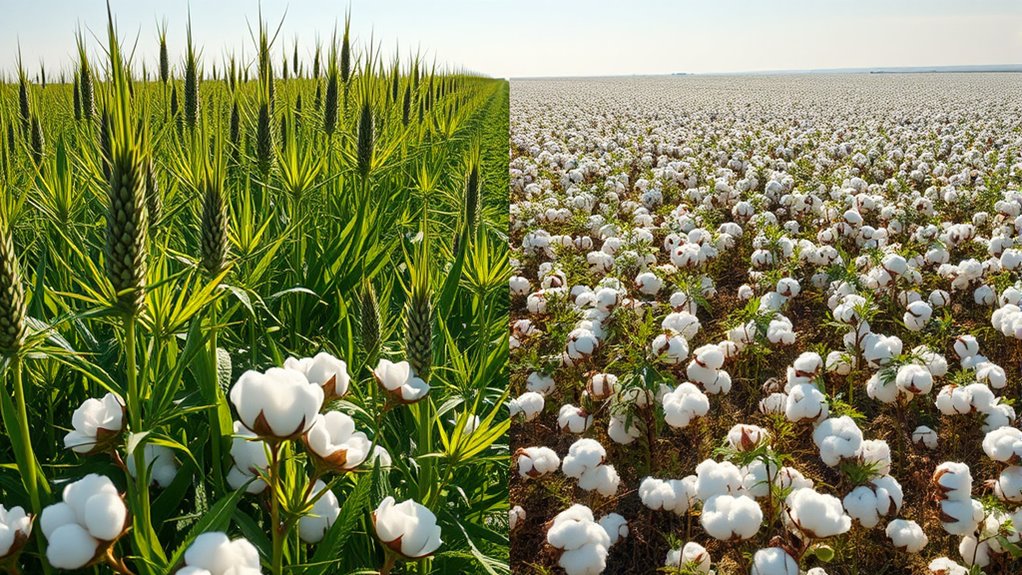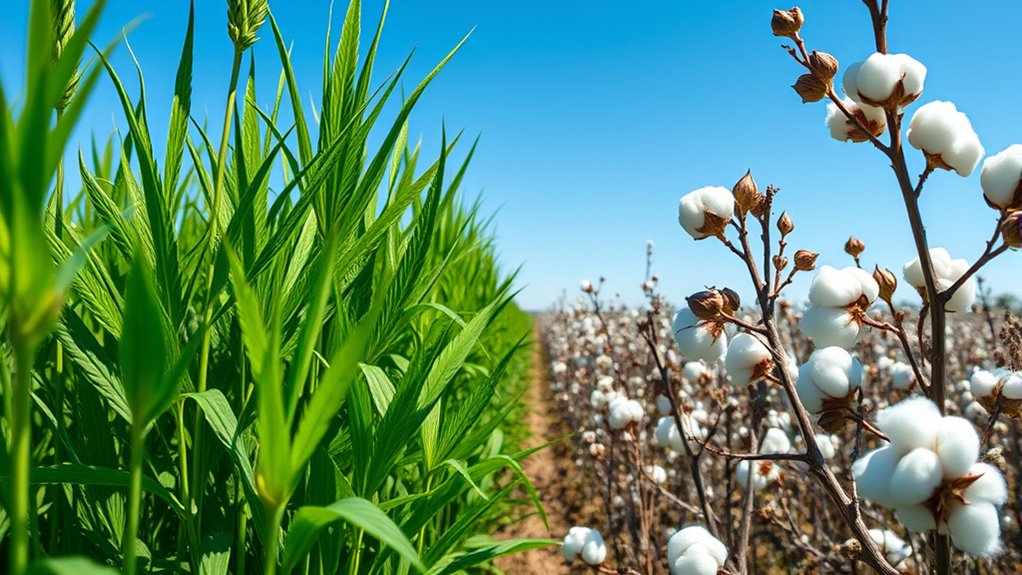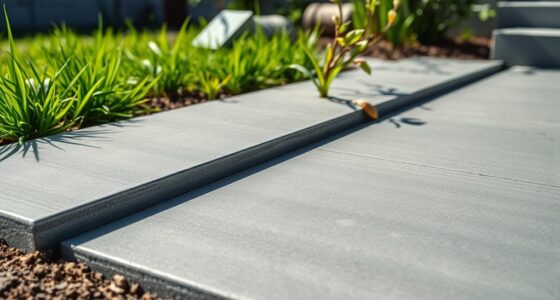Hemp is the more sustainable fiber compared to cotton because it needs less water, fewer pesticides, and a shorter growth cycle. Hemp can thrive in dry climates with minimal irrigation and resists pests naturally, reducing chemical use. Its rapid growth means it can be harvested more frequently, lowering resource consumption overall. If you want to learn how these factors translate into real environmental benefits, keep exploring the details behind each fiber’s impact.
Key Takeaways
- Hemp requires significantly less water and can grow in drier climates, reducing its overall water footprint compared to cotton.
- Hemp naturally resists pests, needing fewer pesticides and chemicals than cotton, lowering environmental and health risks.
- Hemp’s rapid growth cycle allows for quicker harvesting, conserving resources and making it more sustainable than cotton’s longer cycle.
- Cultivating hemp results in less chemical runoff and soil contamination than cotton, supporting healthier ecosystems.
- Hemp fibers are durable, biodegradable, and produced with lower resource inputs, making them a more environmentally friendly choice.

When choosing between hemp and cotton, understanding their environmental impacts and uses can help you make a more informed decision. One of the most significant differences lies in water usage. Cotton requires a substantial amount of water to grow—often thousands of liters per kilogram of fiber. If you’re concerned about conserving water, this makes cotton less sustainable, especially in regions prone to drought. Hemp, on the other hand, needs much less water. It can thrive in drier climates with minimal irrigation, reducing its overall water footprint. This lower water requirement means hemp is a more sustainable choice, especially if you’re aiming to lessen your environmental impact or support water conservation efforts.
Another critical factor to consider is pesticide impact. Cotton cultivation is heavily reliant on pesticides and herbicides to combat pests and weeds, which leads to significant environmental and health concerns. These chemicals can contaminate soil and water supplies, harm wildlife, and pose health risks to farmers and nearby communities. Hemp, however, is naturally resistant to pests and diseases, meaning it generally requires fewer pesticides. This resilience reduces the chemical load associated with its cultivation, making hemp a cleaner, safer option from an environmental perspective. Choosing hemp over cotton can therefore considerably decrease your exposure to harmful chemicals and lessen the ecological damage caused by pesticide runoff.
Beyond water and pesticides, both fibers have different uses and processing considerations. Cotton is widely used in clothing, textiles, and household items, thanks to its softness and breathability. Hemp also serves similar purposes but is gaining popularity for its durability and eco-friendly credentials. Hemp fibers can be processed into fabrics that are strong, resistant to mildew, and biodegradable, making them an attractive alternative to cotton. Additionally, hemp’s rapid growth cycle—often just a few months—means it can be harvested more frequently without depleting resources, further boosting its sustainability credentials.
Frequently Asked Questions
How Does Hemp Cultivation Impact Local Biodiversity?
When you consider how hemp cultivation impacts local biodiversity, you’ll find that it generally offers significant biodiversity benefits. Hemp’s fast-growing nature and minimal cultivation practices help protect native species and reduce soil erosion. Unlike some crops, hemp doesn’t require heavy pesticide use, supporting healthier ecosystems. By choosing sustainable cultivation practices, you contribute to preserving biodiversity, making hemp a more eco-friendly option that benefits local flora and fauna.
Are There Any Health Risks Associated With Hemp or Cotton Fibers?
Did you know that about 2-3% of the population may experience allergy risks from hemp or cotton fibers? Health concerns are generally low, but some individuals might develop skin irritation or allergic reactions. Cotton can sometimes contain residual pesticides, posing additional risks. Hemp is naturally resistant to pests, reducing chemical exposure. Overall, while both fibers are safe for most, it’s wise to be mindful if you have sensitive skin or allergies.
What Are the Water Footprint Differences Between Hemp and Cotton?
You’ll find that hemp has a considerably lower water footprint than cotton, making it more sustainable in terms of water usage. Hemp requires less irrigation efficiency because it’s drought-tolerant and grows quickly, reducing the need for excessive watering. In contrast, cotton demands large amounts of water and intensive irrigation, which can strain local water resources. Choosing hemp helps conserve water and promotes more eco-friendly fiber production.
How Do Processing Methods Affect the Environmental Impact of Each Fiber?
Processing methods dramatically shape each fiber’s environmental impact. You might not realize that chemical processing in cotton manufacturing uses vast amounts of water, energy, and harmful chemicals, leaving a huge footprint. Hemp, on the other hand, requires less chemical processing and energy, making it much gentler on the planet. If you care about sustainability, choosing fibers with minimal chemical treatment and lower energy needs can make a real difference.
Can Hemp Replace Cotton in All Textile Applications?
You might wonder if hemp can replace cotton in all textile applications. While hemp offers excellent fiber performance and is more sustainable, economic feasibility can be a challenge, especially for large-scale production. Hemp’s strength and versatility suit many uses, but certain fabrics require cotton’s softness or specific properties. So, hemp could replace cotton in some areas, but not universally, without considering cost and fiber characteristics.
Conclusion
Ultimately, choosing between hemp and cotton is like selecting a path in a forest—each has its own story to tell. Hemp, with its resilient roots, symbolizes hope and renewal, standing tall against environmental challenges. Cotton, while familiar, often drains the earth’s vigor. Your choice becomes a seed you plant today, shaping a greener tomorrow. By opting for sustainability, you nurture a future where nature’s harmony blossoms anew—an enduring symbol of your commitment.









